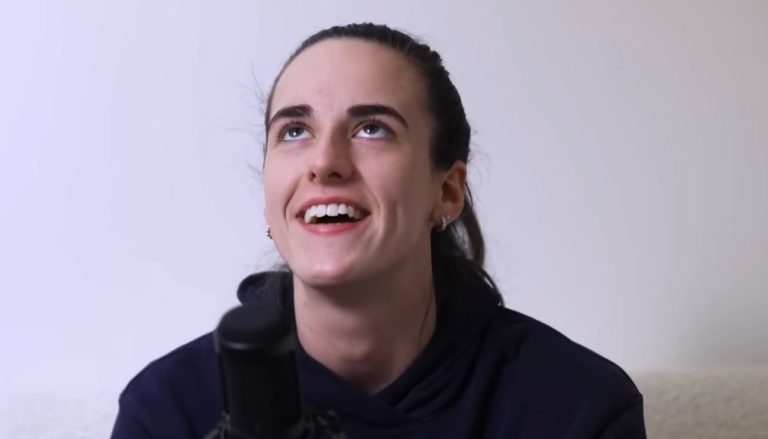Caitlin Clark sparked a movement when she entered the WNBA spotlight, rather than merely joining a league. Similar to the impact Michael Jordan had on the NBA decades before, her arrival immediately turned the Indiana Fever from a routine team into a sellout sensation. Her 2025 base salary is $78,066 despite her extraordinary influence, which seems surprisingly low considering the commercial boom she has sparked.
Her rookie contract, worth $338,056, pays $84,514 a year on average. Her highest yearly salary will be less than $100,000 even if the Fever exercise her 2027 club option, which is still significantly less than the lowest-paid NBA rookie. The difference is striking and hard to overlook: Zaccharie Risacher’s NBA contract was worth $57 million in the same draft year.
Caitlin Clark – Bio, Career & Salary Overview
(Reference: Yahoo Sports)
| Field | Details |
|---|---|
| Full Name | Caitlin Clark |
| Date of Birth | January 22, 2002 |
| Birthplace | Des Moines, Iowa, USA |
| Height | 6 ft 0 in (1.83 m) |
| Position | Guard |
| WNBA Team | Indiana Fever |
| Draft Year | 2024 |
| Draft Pick | 1st Overall |
| Rookie Contract | 4 years, $338,056 |
| Base Salary 2024 | $76,535 |
| Base Salary 2025 | $78,066 |
| Base Salary 2026 | $85,873 |
| Base Salary 2027 | $97,582 (Club Option) |
| Average Annual Salary | $84,514 |
| Major Endorsements | Nike, Gatorade, State Farm, Wilson, Hy-Vee, Xfinity, Gainbridge, Lilly, Panini |
| Estimated Endorsement Earnings (2024) | $11 million |
| Notable Record | Rookie card sold for $660,000 at auction |
But Caitlin Clark’s WNBA salary isn’t the only aspect of her story. She has built a very successful personal brand empire off the court. Her estimated yearly income from endorsement deals with Nike, Gatorade, and State Farm is $11 million, which is significantly more than her on-court compensation. She is now a highly versatile athlete who appeals to audiences outside of basketball thanks to these partnerships, which have been remarkably successful in expanding her reach.
There is no denying her economic influence on the WNBA. When she performs, television ratings skyrocket. Items sell out in a matter of hours. To accommodate demand, teams that host the Fever frequently move games to bigger arenas. Her market dominance was further demonstrated by the record-breaking $660,000 auction price of her rookie card for any female athlete.
The “Caitlin Clark Effect” is more than just a statistical phenomenon. It concerns a change in the perception, appreciation, and celebration of women’s sports. Her presence is consistent with a larger, noticeably better trend of increasing media rights valuations in women’s sports, according to Harvard’s Judd Cramer. By attracting casual viewers who had previously ignored the women’s game, she has developed into a cultural bridge.
However, her pay is still subject to the collective bargaining agreement of the WNBA, which forbids renegotiation until the end of the contract. Even WNBA Commissioner Cathy Engelbert admits to the pay disparity, but she cites more marketing opportunities and bonuses that could increase her yearly league income to close to $500,000. Even though this is a huge improvement over her base pay, teams still find it surprisingly affordable given the massive financial returns she produces.
Her situation is representative of the greater reality faced by many top female athletes, who rely more on endorsements than base pay. Simone Biles, Naomi Osaka, and Megan Rapinoe all follow this model, which prioritizes brand deals over on-field pay. The disparity in Clark’s situation is stark; her WNBA earnings only account for 1% of her overall income.
However, her influence is far more valuable than any salary. John Kosner, a former ESPN executive, has even compared her early influence to that of greats like Tiger Woods and Muhammad Ali, highlighting the fact that people who were previously uninterested in women’s basketball are now ardent fans. The fan base of a league can grow steadily over time with that kind of reach.
Her ascent has a social component as well. She is viewed by young athletes, especially girls, as evidence that skill and perseverance can result in national fame. As a result of her remarkable accomplishments, aspiring athletes are now lining up in gyms throughout Iowa and beyond, donning her jersey. Her prominence is not only advantageous for the sport now, but it is also essential for its future.
If she keeps up her current pace, Caitlin Clark might have an impact on the upcoming collective bargaining agreement that significantly raises player salaries and revenue sharing. According to the WNBA’s recent billion-dollar expansion negotiations, the revenue pool may increase significantly, freeing up more funds for market-value salaries.
Until then, her $78,066 salary will serve as a focal point for discussions about equality in professional sports as well as a statistical curiosity. Caitlin Clark has already demonstrated that she is more than just an athlete; she is a force to be reckoned with in the marketing industry, a change agent, and an inspiration to others about what can be achieved when talent and opportunity come together. Her story is about momentum, visibility, and the incredible power of one player to elevate an entire league—it’s not just about numbers.


